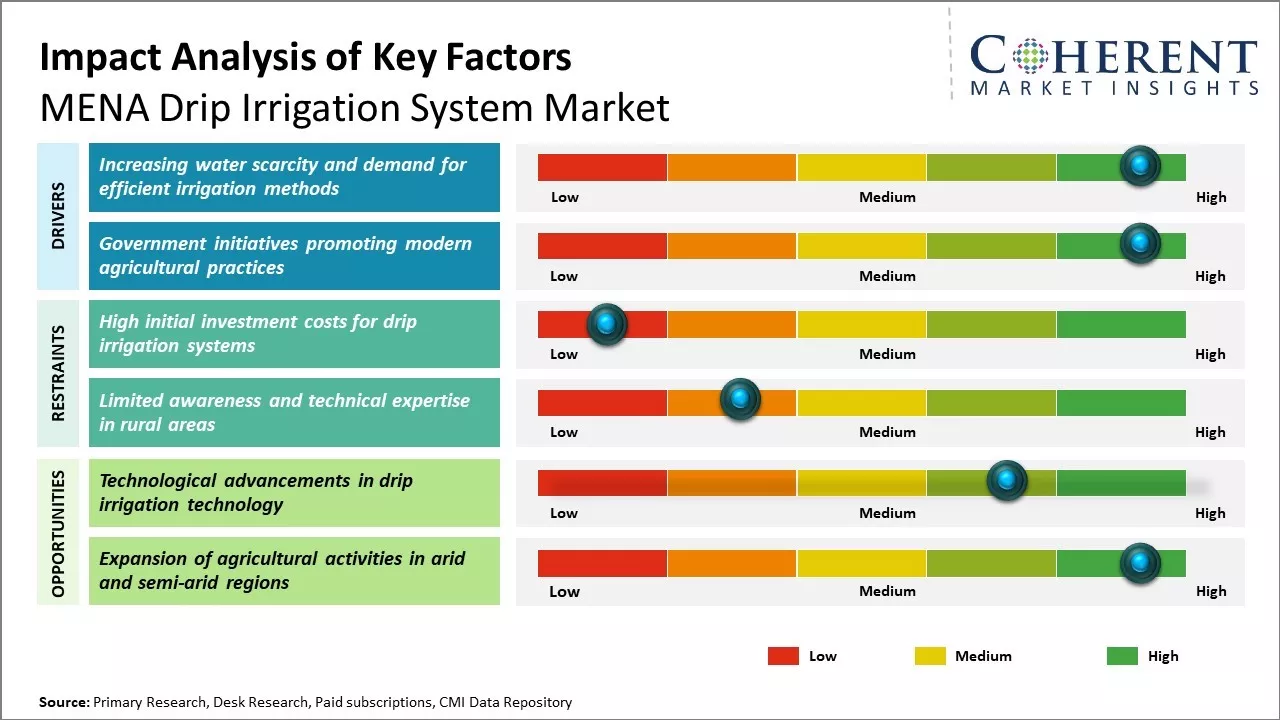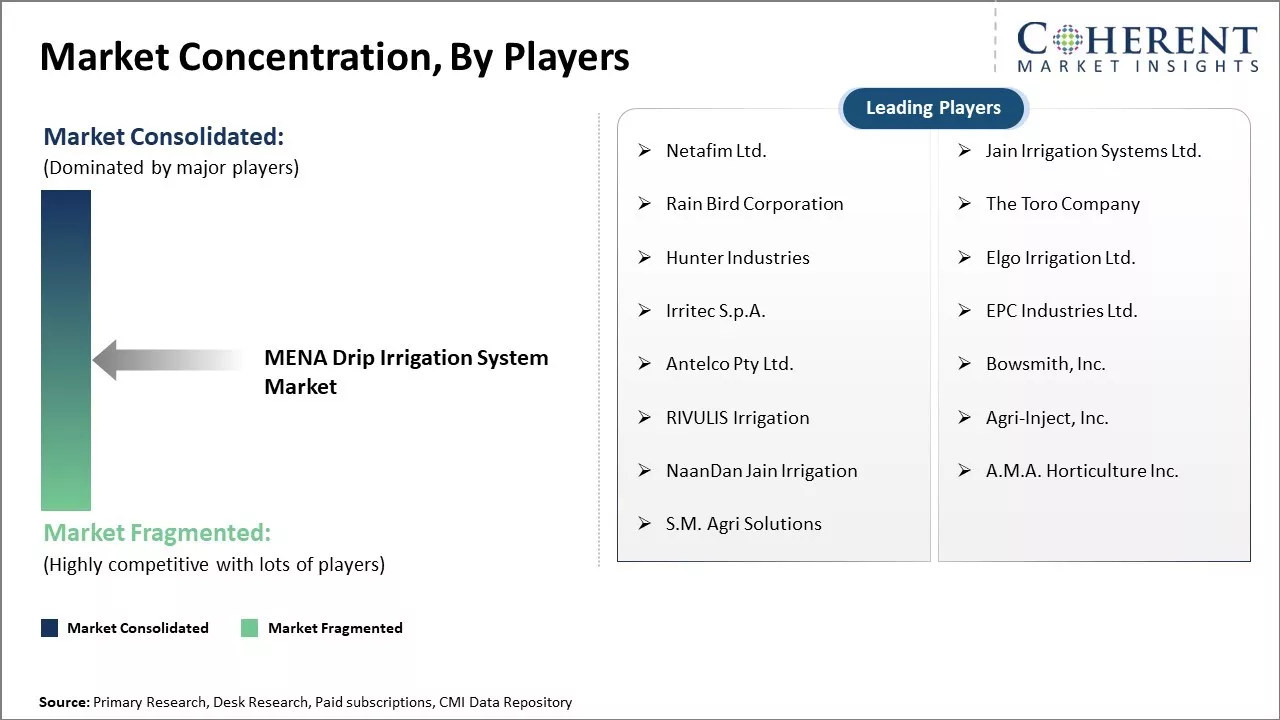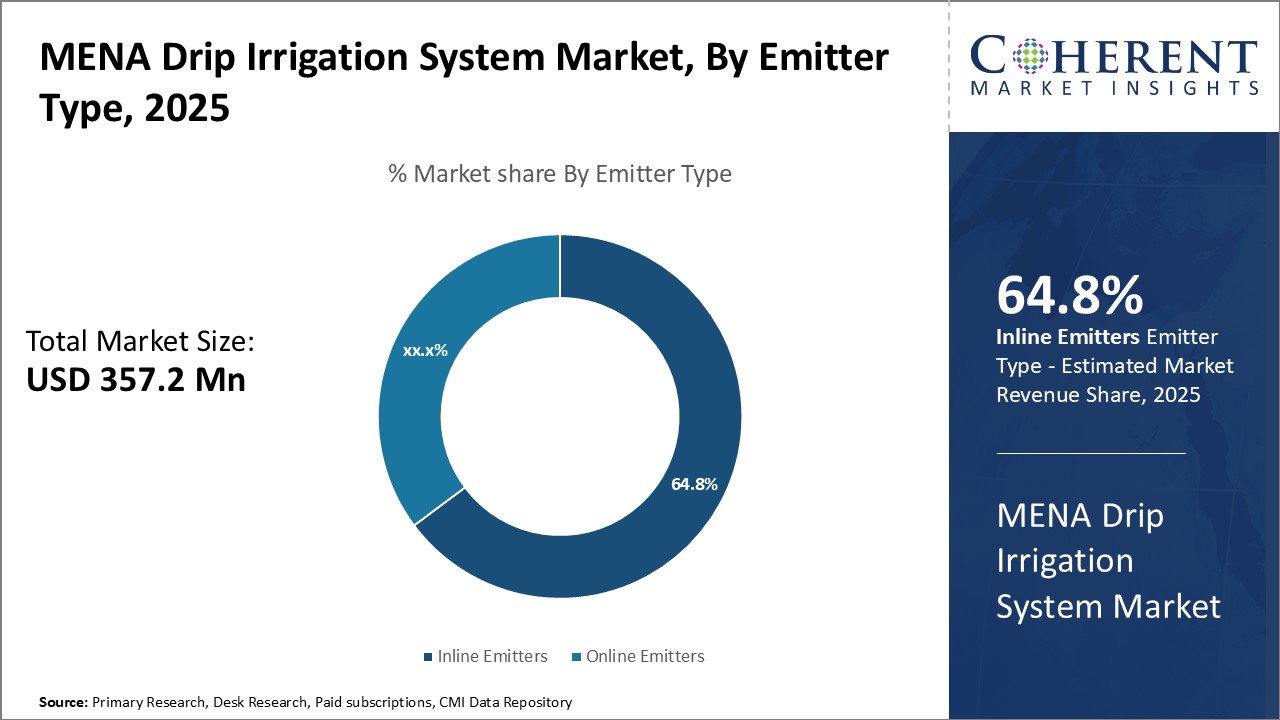The MENA drip irrigation system market is estimated to be valued at US$ 357.2 Mn in 2025 and is expected to reach US$ 1,166.0 Mn by 2032, exhibiting a compound annual growth rate (CAGR) of 18.4% from 2025 to 2032.

Discover market dynamics shaping the industry: Download Free Sample
Governments across the region are promoting water conservation methods for efficient use of water resources in agriculture. This is expected to drive increased adoption of drip irrigation systems in the coming years.
The market is set to witness significant growth during the forecast period owing to rising concerns about water scarcity and increasing emphasis on water conservation across agricultural practices. Changing climatic conditions and fluctuation in rainfall patterns have further increased the dependency on irrigation and the use of drip irrigation for uniform water distribution and fertilizer application.
Market Driver - Increasing water scarcity and demand for efficient irrigation methods
The Middle East and North Africa region has been facing severe water scarcity issues in the recent past due to low and irregular rainfall along with increasing temperatures caused by global warming. This has resulted in depletion of groundwater resources and reduction in availability of freshwater for agricultural as well as domestic needs.
Drip irrigation systems, also known as trickle irrigation systems, emerged as one of the most viable options to irrigate agricultural fields and orchards in a localized and targeted manner. With individual emitters or drippers placed close to the root zone of each plant, drip systems can deliver water directly to the base of the plants slowly and precisely only where it is required. Compared to surface irrigation techniques, drip allows saving up to 50-90% of water through controlled and minimal soil evaporation. It also helps achieve higher crop yields through uniform soil moisture maintenance and minimized leaching losses of fertilizers below the root zone.
For instance, in September 2023, Elgo, a leading manufacturer of irrigation systems and technologies, launched an innovative series of pressure compensating drippers designed specifically for uneven terrains. This new product line aims to improve water efficiency and ensure uniform irrigation across challenging landscapes, addressing the needs of farmers and agricultural businesses. By introducing these advanced drippers, Elgo seeks to enhance its offerings in the irrigation market and support sustainable farming practices in diverse environments.

Get actionable strategies to beat competition: Download Free Sample
Government initiatives promoting modern agricultural practices
Governments across the MENA region have launched several initiatives and policies in the past decade focusing on agricultural modernization and sustainability. Since water is a highly critical natural resource for the socio-economic development in these nations, improving irrigation infrastructure and techniques has been a major area of focus.
Subsidy programs offering 30-50% financial support on the installation of modern irrigation systems like drip and sprinklers have encouraged thousands of smallholder farmers to switch from conventional flooding. Educational campaigns emphasizing the benefits of scientific farming with precise irrigation have increased awareness. Certification incentives are awarded to cultivators adopting best-in-class irrigation technologies and achieving higher crop water productivity. Comprehensive water policies restricting extraction from underground reserves and canals have boosted conservation efforts.
Governments played an active role in the promotion of drip irrigation through direct procurement and distribution projects. Mass irrigation projects deploying drip kits across large areas have covered over 500,000 hectares in nations like Iran, Saudi Arabia, Egypt, Morocco, and Jordan. Capacity building initiatives trained thousands of irrigation specialists, distributors, suppliers, and installers. Governments also strengthened the manufacturing ecosystem through investments, approvals and quality standards. All these initiatives have cumulatively accelerated the installation rate of modern irrigation systems like drip in the MENA region. The significant government support has definitely been a major driver contributing to the increased adoption and expanding market size of drip irrigation systems.
Key Takeaways from Analyst:
One of the key drivers for the market is the increasing strain on water resources across the region. Countries like Israel, UAE, and Saudi Arabia are pushing for more efficient irrigation solutions to address water scarcity issues. Drip irrigation significantly reduces water usage compared to traditional sprinkler systems and offers higher yields as well. Hence, governments are promoting drip irrigation through various subsidies. Another major opportunity is the expansion of cultivated areas. More farms are looking to cultivate crops through the year instead of just seasonal harvests with the help of drip irrigation.
However, high initial installation costs of drip irrigation pipelines and components pose a major challenge to widespread adoption. This is a key restraint especially in price-sensitive markets. Lack of proper technical know-how among farmers is also restricting the market's potential currently. Israel dominates the MENA region with widespread adoption due to years of technical expertise in drip irrigation. But countries like UAE, Saudi Arabia, and Morocco are growing the fastest as they aggressively promote water-saving solutions. If costs come down and more training is provided, drip irrigation can transform agriculture across MENA in the coming decade.
Market Challenge - High initial investment costs for drip irrigation systems
One of the major challenges facing the widespread adoption of drip irrigation systems in the MENA region is the high initial investment costs associated with installing these systems. Setting up an underground pipeline network and installing drippers or emitters on fields requires a substantial upfront capital outlay for farmers. The expense of purchasing the various components such as backflow preventers, filters, valves, pipes, pumps and drippers puts pressure on farmers' budgets. Many smallholder farmers and those with limited access to financing find it difficult to afford these systems in one go. The high initial costs deter some farmers from transitioning to more efficient drip irrigation and prompt them to rely on traditional flood or spray irrigation methods instead. Governments and irrigation authorities need to offer subsidies, low interest loans or financing options to help lower the financial barriers and make drip irrigation economically viable for more farmers.
Market Opportunity: Technological advancements in drip irrigation technology
One of the major opportunities for the growth of the drip irrigation market in MENA is the ongoing technological advancements in drip irrigation systems. For example, the use of self-compensating drippers that maintain a constant flow rate despite changes in water pressure in the pipeline are becoming more common. Other innovations include moisture sensors to automate irrigation, solar powered pumps to reduce energy costs, and integrated filters to simplify maintenance. The emergence of low cost drip tapes made of agricultural waste is also increasing the feasibility of drip irrigation for small fields. As the components become cheaper and more versatile, it will boost uptake of drip systems among more farmers and in more regions within MENA. The potential for digitization of drip irrigation through IoT integration also creates new prospects for optimization and remote monitoring of systems. Overall, continuous advances are expanding the addressable market scope for drip irrigation in MENA.

Discover high revenue pocket segments and roadmap to it: Download Free Sample
Insights By Emitter Type - Inline Emitters Segment Dominates Market, Driven by Optimal Efficiency and Consistency
In terms of Emitter Type, Inline Emitters segment is estimated to contribute the highest market share of 64.8% in 2025 owing to their optimal efficiency and consistency. Inline emitters are directly incorporated into drip lines or drip tapes during the manufacturing process itself. This integrated design ensures a uniform distribution of water along the entire length of the tube. The in-built emitters are not prone to clogging issues like online emitters and can maintain a constant discharge rate over longer periods of time. Their permeability is less affected by factors such as water pressure fluctuations. This consistency in performance across diverse agricultural fields and environmental conditions has made inline emitters a preferred option among MENA farmers. Other advantages like ease of installation along contour lines and compatibility with various tube diameters have further increased their popularity. Major manufacturers focus more on inline emitter R&D given their high demand, bringing continued technology upgrades that boost yield for crops. Overall, superior hydraulics and reliability have helped inline emitters dominate the emitter type segment in the MENA region.
Insights By Component - Drippers Segment Leads Market, Driven by Precise Irrigation Capabilities
In terms of Component, Drippers segment is estimated to contribute the highest market share of 32.3% in 2025 owing to being the key element that facilitates precise irrigation. Drippers play a vital role in the drip irrigation system by regulating the discharge of water onto the root zone of individual plants. Unlike traditional surface irrigation techniques, drip ensures that every drop of water is utilized efficiently through the dripping mechanism. This has led to growing prominence of drippers across diverse terrains and cultivations in MENA. The diversity in dripper designs such as pressure-compensation, inline, and online varieties provide customized solutions tailored for different crops and soil types. Steady technological advancement has improved the anti-clogging capability and discharge uniformity of drippers. Meanwhile, mass production has made them more affordable for widespread adoption. With most farmers recognizing the yield-boosting potential of drip irrigation, demand for high-performing drippers keeps rising. This sustained appetite for the critical component sustains dripper segment's market dominance.
In October 2022, Rain Bird Corporation, a leading global manufacturer of irrigation products and services, partnered with local governments in North Africa to promote sustainable irrigation practices. This collaboration aims to enhance water conservation efforts and improve agricultural productivity in the region by implementing advanced irrigation technologies. By working closely with local authorities, Rain Bird seeks to support sustainable farming initiatives and address the challenges posed by water scarcity in North Africa, reinforcing its commitment to the intelligent use of water.
Insights By Application - Agriculture Segment Dominates Market, Driven by Benefits to Crop Farming
In terms of Application, Agriculture segment is estimated to contribute the highest market share of 49.7% in 2025 owing to the numerous benefits brought to crop farming. Compared to other applications, agriculture sees larger scale deployment of drip irrigation systems across vast land areas. This is driven by drip's ability to maximize crop yields from the same water supply. By delivering tiny water amounts precisely to root zones, evaporation and deep percolation losses are curbed significantly. Simultaneously, it helps maintain critical soil moisture levels even during dry periods to reduce crop stress. Pest infestation risks are also lowered as wet foliage is minimized. Drip proves highly suitable for various cereals, fruits, vegetables and cash crops that are economic mainstays of the region. It has proved revolutionary particularly for water guzzler crops grown on sandy soils. Subsequently, agriculture has emerged as the biggest growth area for MENA's drip irrigation market. Heightened food security concerns amid climate shifts will sustain this segment's important role going forward.
MENA Drip Irrigation System Market Report Coverage
| Report Coverage | Details | ||
|---|---|---|---|
| Base Year: | 2024 | Market Size in 2025: | USD 357.2 Mn |
| Historical Data for: | 2020 To 2024 | Forecast Period: | 2025 To 2032 |
| Forecast Period 2025 to 2032 CAGR: | 18.4% | 2032 Value Projection: | USD 1,166.0 Mn |
| Segments covered: |
|
||
| Companies covered: |
Netafim Ltd., Jain Irrigation Systems Ltd., Rain Bird Corporation, The Toro Company, Hunter Industries, Elgo Irrigation Ltd., Irritec S.p.A., EPC Industries Ltd., Antelco Pty Ltd., Bowsmith, Inc., RIVULIS Irrigation, Agri-Inject, Inc., NaanDan Jain Irrigation, A.M.A. Horticulture Inc., and S.M. Agri Solutions |
||
| Growth Drivers: |
|
||
| Restraints & Challenges: |
|
||
Uncover macros and micros vetted on 75+ parameters: Get instant access to report
*Definition: The MENA Drip Irrigation System Market involves the sale of drip irrigation systems and components primarily in the Middle East and North Africa region. It provides efficient and affordable irrigation solutions for farms and agricultural land through a network of valves, pipes, tubes, and emitters that slowly deliver water directly to plant roots. Drip irrigation systems conserve water and fertilizers, improve crop quality and yields, and simplify farming operations.
Share
Share
About Author
Ankur Rai is a Research Consultant with over 5 years of experience in handling consulting and syndicated reports across diverse sectors. He manages consulting and market research projects centered on go-to-market strategy, opportunity analysis, competitive landscape, and market size estimation and forecasting. He also advises clients on identifying and targeting absolute opportunities to penetrate untapped markets.
Missing comfort of reading report in your local language? Find your preferred language :
Transform your Strategy with Exclusive Trending Reports :
Frequently Asked Questions
Joining thousands of companies around the world committed to making the Excellent Business Solutions.
View All Our Clients